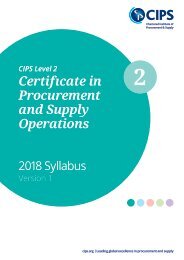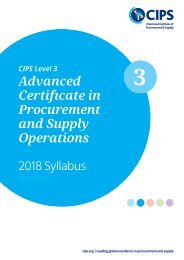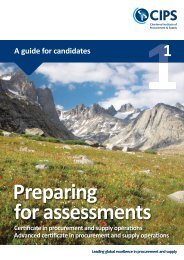Preparing for CIPS Diploma level assessments
Create successful ePaper yourself
Turn your PDF publications into a flip-book with our unique Google optimized e-Paper software.
Make sure you understand exactly what<br />
you are being asked to do: <strong>for</strong> example<br />
‘Propose’ means put <strong>for</strong>ward (<strong>for</strong><br />
example, a point of view, idea, argument,<br />
suggestion) <strong>for</strong> consideration or action,<br />
and you should write your answer with<br />
this in mind, as if you were putting your<br />
proposal to a company’s management<br />
team. ‘Evaluate’, on the other hand,<br />
requires you to calculate or judge the<br />
value of something, and include theory<br />
and/or your personal opinion in your<br />
evaluation<br />
If you are asked to give examples, or<br />
quote theories or models, make sure that<br />
you relate the theory/model to the case<br />
study<br />
• During the assessment, do not duplicate any<br />
large pieces of factual in<strong>for</strong>mation from the<br />
case study, just reference it within your<br />
answer: <strong>for</strong> example ‘on page number 6 of<br />
the case study, figure one shows financial<br />
in<strong>for</strong>mation…’. This will save you time, which<br />
you can spend on your answers<br />
• Start each answer on a new page, leaving<br />
space after completing the previous<br />
question. This enables you to include a few<br />
words more, on review of your answer,<br />
should another aspect of the points you<br />
have made come to mind. Leaving space<br />
also makes it easier <strong>for</strong> the assessor to see<br />
the points you have made clearly, when<br />
allocating marks. Use sections and subsections<br />
<strong>for</strong> your answers, to aid the flow<br />
from one section of your answer to the next<br />
When using diagrams always label them and<br />
reference them, making sure they have a<br />
clear purpose<br />
• Make your handwriting as legible as possible<br />
(practice be<strong>for</strong>ehand if necessary). In an age<br />
where increasingly we use computers,<br />
tablets, and mobile devices, this is very<br />
important. Using a fountain pen or even a<br />
fibre tip pen can help. Assessors can only<br />
mark what they can read and interpret fully,<br />
so if they can’t read your writing you may<br />
not gain the marks you deserve<br />
• Remember, the purpose of this case study is<br />
to allow you to demonstrate:<br />
Analysis and critical thinking<br />
Decision-making<br />
Judging between courses of action<br />
Handling assumptions and inferences<br />
Presenting a point of view<br />
Listening to and understanding others<br />
Relating theory to practice.<br />
Use of relevant models <strong>for</strong> the sector in<br />
which the case study is based.<br />
It is important that you seize the opportunity<br />
to demonstrate any or all of these throughout<br />
your answers. The person marking your case<br />
study answers does not know you, so you need<br />
to show your knowledge in a similar way to<br />
approaching a job interview – you have to help<br />
them to recognise that you know your<br />
material, and if you don’t, the assessor will not<br />
make any allowances <strong>for</strong> what you missed out!<br />
• Please note that all work should be your<br />
own. Copying or plagiarism will not be<br />
tolerated and could result in no marks being<br />
awarded. If quotes or short extracts are<br />
used they should be attributed or the source<br />
of the in<strong>for</strong>mation identified.<br />
Recommended time to spend on pre-released case-study assessment papers (three hours duration)<br />
Planning/making notes <strong>for</strong> answers (per question)<br />
Writing (per question)<br />
Checking/amending (per question)<br />
Checking that you have correctly followed the instructions, missed nothing out,<br />
labelled everything, last-minute amendments (per assessment)<br />
7 minutes<br />
30 minutes<br />
3 minutes<br />
5 minutes<br />
www.cips.org<br />
19
















